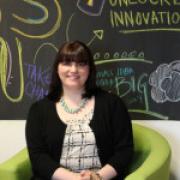Architecting Happiness
Every organization states that they want to make their users happy, but who is really delivering on those promises? Who is really architecting for happiness? On February 21, 2015 we want to ask the world to help us uncover answers to questions we believe to be critical to the future of how we practice information architecture: How can information affect happiness? How can we best architect structures for information that promote happiness? What work are organizations doing to bridge the gaps we face as we transition from a primarily analog to a primarily digital way of life? Learn from world-class minds in the user experience field, network with your peers, and showcase new ideas at a free event tailored specifically for the DC community. Whether you are new to information architecture or an experienced practitioner, this event will inspire you to push the boundaries of IA to make the world a happier place.
Venue, parking and transit
Hosted at Sapient: 1515 N Courthouse Road, 4th Floor, Arlington, VA 22201
We are located two blocks from the Courthouse Metro Station on the Orange Line.
Program/Schedule
- 8:45 - 9:15 Breakfast and Networking
- Enjoy coffee and breakfast, provided by Sapient.
- 9:15 - 9:30 Introductions and Welcome
- 09:30 - 10:45 Opening Keynote: The Architecture of Advocacy
- 10:45 - 11:00 Morning Break
- 11:00 - 12:00 Setting Structure for Social Comfort
- 12:00 - 01:15 Lunch and Discussion
- After grabbing your lunch, provided by Sapient, join your colleagues for small discussions around different aspects of information architecture. It will be an organic conversation, though there will be one discussion lead per room to help get the conversation going. Topics will be announced at the event.
- 1:15 - 2:15 Panel Discussion: Quantifying Happiness
- 2:15 - 2:30 Afternoon Break
- 2:30 - 4:00 Workshop: The Designer is Present
- 4:00 - 4:15 Afternoon Break
- 4:15 - 5:15 Lightning Talks
- 5:15 - 5:30 Closing Remarks and Raffle
- Stick around for our exciting raffles at the end of the event. Thank you to our local partners and global sponsors for their donations.
- 5:30 - 6:30 Happy Hour
- Join us for drinks and discussion, sponsored by General Assembly.
Opening Keynote: The Architecture of Advocacy
Christina Wodtke:The Architecture of Advocacy
Perhaps school taught you how to make a taxonomy or create a persona from research, but did it teach you how to ask for a raise? How to create consensus between your team, product and engineering? Or how to get the right design out in the face of the “just copy Amazon/Google/Netflix” argument?
Designers are taught the skills to make good design, but not the ones that will assure that design will go live. In this talk, I’ll cover key skills every UX practitioner should know.
The techniques I’ll teach are based on a combination of Nonviolent Communication, John Kotter’s Buy In, FBI negotiation techniques, and from real life in the Silicon Valley.
Attendees will learn:
- How to build consensus
- How to argue and listen effectively
- How to stay zen when the situation gets hot
- How to get buy in
- How to ask for what you need
While designers historically have shrunk away from selling, It’s not gross or ugly to ask for what you need to get the job done right. If designers want a place at the table, they will have to ask for it.
Session 2: Setting Structure for Social Comfort
Thomas Vander Wal: Setting Structure for Social Comfort
Social and collaborative elements have woven their way into many sites, services, and applications but often it is not done with the thought and understanding required. Structuring for social comfort is a basic need that is often overlooked. The talk will give insight into the three high level focus areas for social comfort: tools, people, and content. Then the talk will focus on how to frame structure for what is needed from an IA perspective to improve social comfort, increasing happiness where we interact, share, and collaborate with others.
Session 3: Panel Discussion: Quantifying Happiness
Panel Discussion: Quantifying Happiness
Featuring:
- Dom Crockett, Design Researcher, Motivate Design
- Dustin DiTommaso, Senior Vice President, Behavior Change Design, Mad*Pow
- Steve Wendel, Panel Moderator; Principal Scientist at HelloWallet
- Dave Jeyes, Product Manager & UX Researcher, AddThis
- Hilding Anderson, Director of Research & Insights, SapientNitro
Are your users happy, with your product and what it means in their lives? In this panel, you'll hear diverse perspectives on quantifying - and influencing - user happiness. Our panelists are consultants, gamification experts, and digital marketers. Each will answer:
- What user happiness means
- How to measure it
- How happiness can be shaped or built in a digital environment
Session 4: Workshop: The Designer is Present
Steve Portigal: Workshop: The Designer is Present
Therapists, as part of their education, must go through therapy themselves. They are expected to achieve a certain level of insight about themselves – their biases, their discomforts, and so on. While we are not therapists, we go out and study people without that level of self-insight! A lack of self-insight sometimes manifests itself as passion, commitment, or being driven by a mission. While those have their place, it’s easy to become blinded by what we can’t let ourselves see. Sometimes this shows up as discomfort at the micro level, when we react to something a user might tell us about themselves; sometimes it’s a macro issue, when we’re uncomfortable with people who hold different values, preferences, or beliefs than ourselves. And it crescendos as know-it-all douchebaggery, when we think our job is to tell other people what’s best for them – when phrases like “frictionless sharing” fall from our lips as naturally as “what time is dinner?”
In this workshop we will delve into the concepts of presence and mindfulness and develop an understanding of how this informs how you engage with the world around you, as a designer and a professional and as a person.
Session 5: Lightning Talks
Lesley Humphreys: Positive Psychology and the Architecture of Information Happiness
The science of happiness has come a long way in recent decades: prominent scholars such as Dr. Martin Seligman and Dr. Tal Ben-Shahar have studied and written about the impact that positive psychology can have in our lives. In this short talk I’ll illustrate how select principles from their writings can be brought to bear on our work with clients. For example, in his book "Happier," Dr. Ben-Shahar describes how explicitly committing to goals helps us actually create reality by focusing our attention – so if we can arrive at the right level of goal-setting (in the stretch zone as opposed to the panic zone!) we and our clients are happy at the sense of accomplishment we’ve achieved. Slides
Greg Walsh: Kidsteam: Designing with your Audience
This talk will introduce the concept of co-design - designing with your target audience as partners. The concept was popularized in Scandinavian countries during the late 1980's and utilized with children a decade later in the United States. Today, major corporations are forming their own co-design teams with children in order to architect the best possible products for their audience. We will discuss Nickelodeon, Pearson Publishing, and a number of other organizations utilizing this design method. Although this talk focuses on existing examples of co-design with children, it will be relevant for anyone architecting user experiences for a particular audience.
JZ: Card-Based UI
Pinterest, Twitter, and now Facebook, Google, are using card-based UI: but what is it? Learn how to design S, M, L cards once, instead of 3x for each responsive element. Re-stack and shuffle, without scuffle, between mobile, tablet, and desktop browser widths. Learn how cards leverage dynamic data, delighting engineers and users alike. Join the card designing movement.
Carla Brown: Good Design Comes from Vision Alignment
How often have you asked for your client's vision, and received a lot of unhelpful business language? Let's discuss how to coach clients so they give you a meaningful and inspirational narrative. Then you can create a design that reverberates with the client & their customers. In a survey of innovation leaders, 62% said that the main challenge to getting truly innovative results is alignment between the leadership and the creative teams. Only 11% said the issue was creating new ideas and 27% said it was fear. So how do you architect this alignment up front?
John Whalen: Architecting Information for the Mind: Introducing Emergent UX
UX has become a vital component of mission-critical projects. But you can’t just start designing screens. UX doesn’t happen on a screen – it happens in the mind. This talk introduces Emergent UX - a process designed to dramatically improve product design by deeply understanding your audience's conscious and unconscious needs on cognitive and emotional levels. We describe how we go beyond traditional UX techniques by using psychology to deeply understand what is in your users’ mind (or minds), what deliverables we produce, and how to apply that concretely to UX design. Learn about the six minds, what it takes to seduce them, and how to add Emergent UX processes to your projects. Slides





